The Bay Trail Preview: Intel Atom Z3770 Tested
by Anand Lal Shimpi & Brian Klug on September 11, 2013 12:00 PM ESTIn addition to showing Bay Trail running on a Windows 8.x platform, Intel showed us a “pre-beta” version of the platform running Android 4.2.2. I have to emphasize that the build they showed us definitely seemed pre-beta, as there was some instability, but overall the build was good enough to run some tests on and get a feel for. Intel made it clear that they do have a lot more work to do on their Android build before it’s considered close to final quality than the Windows equivalent.
Inside Android we can still see the CPU state table data and how long the cores are sitting in each performance state still, despite this now being managed in-silicon on Bay Trail. In addition Android sees the 2.39 GHz Z3770 boost frequency and reports it. I didn’t see any strange behavior on the device while running tests and watching CPU frequency, if anything the reference design platform stayed at the maximum boost frequency even with four cores plugged in for an impressive amount of time. Of course this is a tablet so there’s more TDP to play around with compared to a phone.
Depending on where you were in the Android UI, there was some definite stutter, but I’m told this is a result of an issue with Dalvik not allocating threads to cores properly that Intel is still tuning, something which you can see plays itself out as well in the AndEBench Java test that runs in Dalvik. The launcher especially had some stutter, but Intel claimed they were aware of it and that final performance in areas like that would be dramatically improved. Regardless of the state of Bay Trail’s Android port, it affords us the opportunity to look at performance through our pretty standard benchmark suite.
On the CPU side for Android we’re still limited to just a few tests that rely on a combination of native code and stuff that runs inside the browser. That means AndEBench, JavaScript benchmarks, and part of Vellamo.
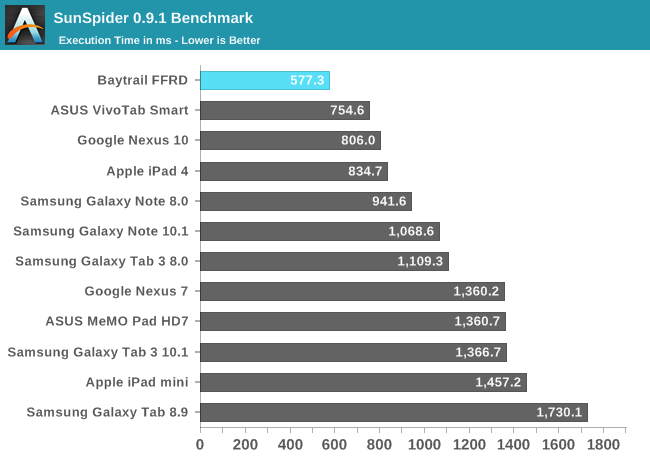
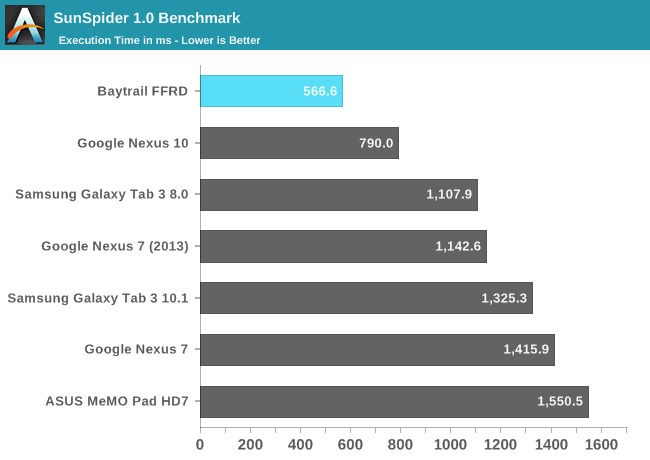
Sunspider has been a regular staple but in recent time has become an exercise in browser JavaScript engine optimization rather than actual performance. Nevertheless the FFRD takes the crown in both 1.0 and 0.9.1 (we have more tablet data from the 0.9.1 version so I replicated it here).
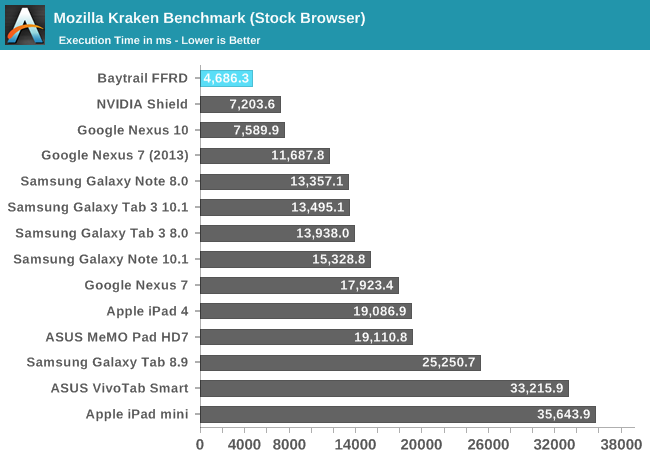
Kraken is another JavaScript benchmark which hasn’t quite been an optimization target everyone has gone after lately, and it’s also longer, which makes it a bit more reliable. Once again Bay Trail takes the crown here with notably faster JS engine performance.
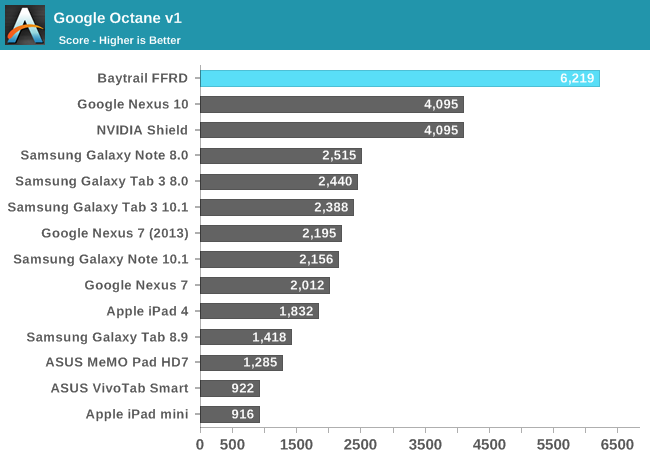
Google Octane is another JS test that isn’t quite as platform optimized yet, here there’s once again dominance by Bay Trail with just over a 50 percent higher score.
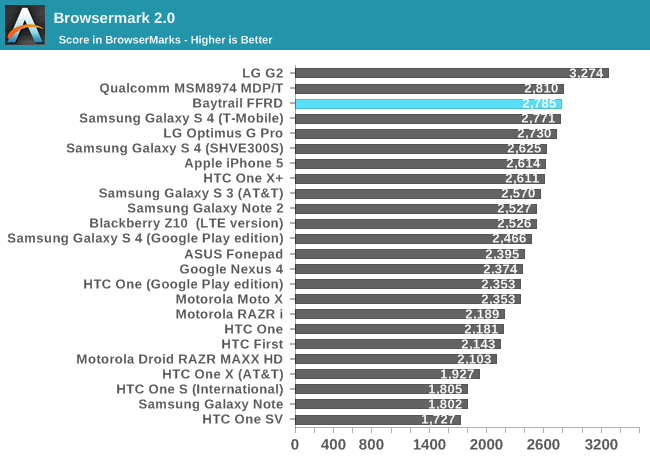
Browsermark has a combination of both JS tests and other web related performance metrics. Here the Bay Trail platform lags behind the 8974 based devices slightly. This isn’t a raw JavaScript benchmark again but rather a more holistic web browsing performance test, so it’s interesting to see Bay Trail a bit behind here.
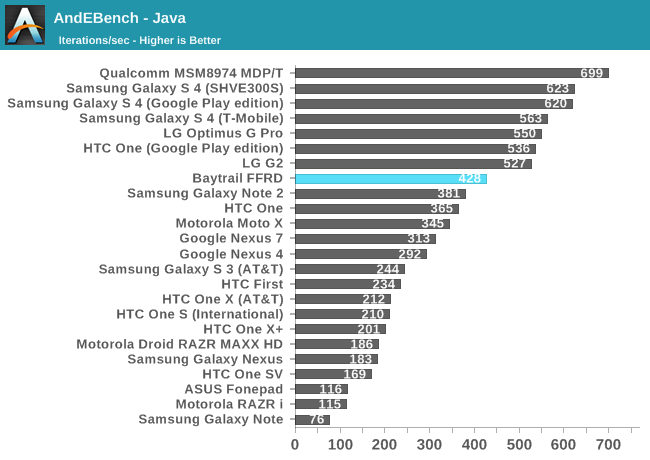

AndEBench is a combination native compiled microkernel benchmark (indicative of NDK application performance) that also runs a very similar workload atop Dalvik like a normal Android Java application. Here we can see what Intel was talking about when they said they have more work to do getting Dalvik working properly at dispatching threads to appropriate cores, hopefully the Java number will climb considerably. The native test also shows a lead over the competition.
GPU Performance
While Bay Trail clearly leads on the CPU side, its GPU performance is more middle of the road - at least among the higher end SoCs. In 3DMark Bay Trail's GPU performance is aided by the more CPU bound nature of the benchmark, but here Intel is able to beat the Snapdragon 600. Snapdragon 800 on the other hand pulls ahead by around 35%.
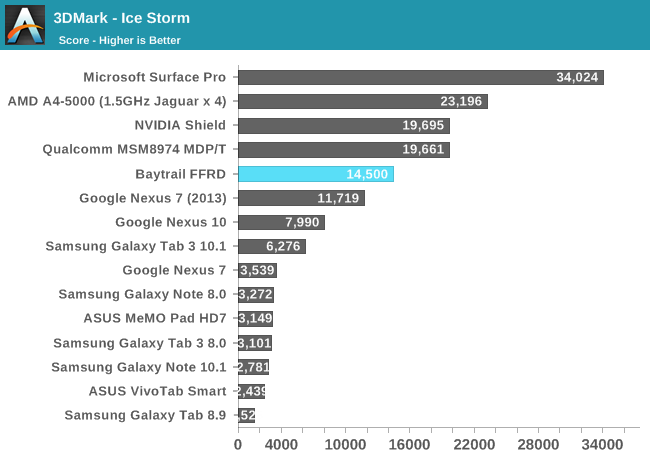
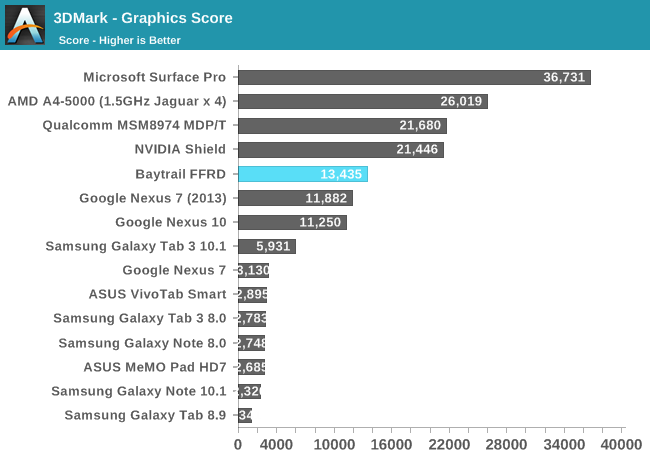
The 3DMark Physics test is effectively a CPU test, which once again plays to Bay Trail's strengths. Here it's faster than Snapdragon 800 and Cortex A15. Only Ivy Bridge is quicker in a tablet.
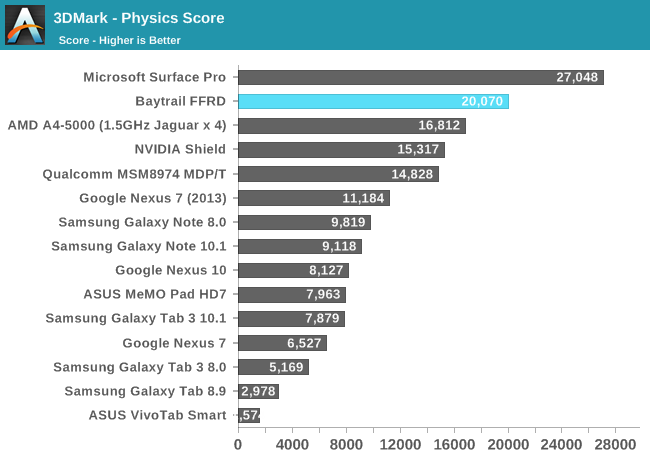
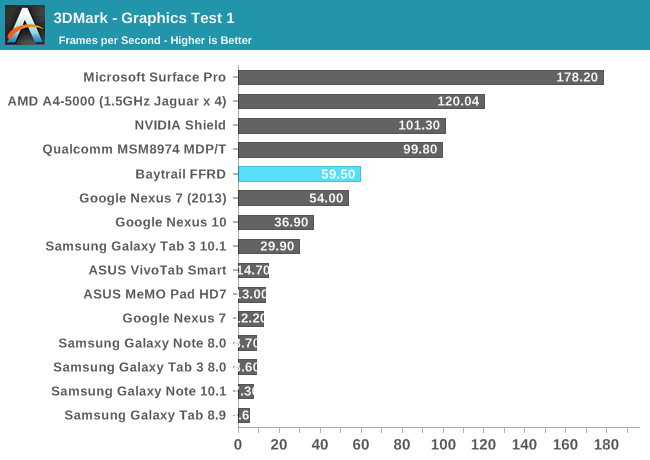
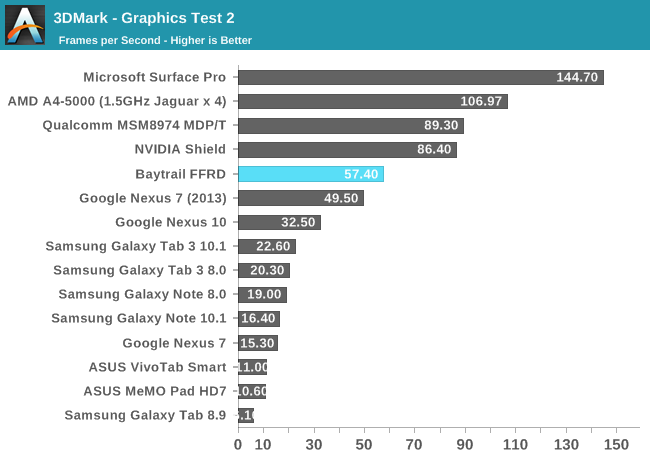
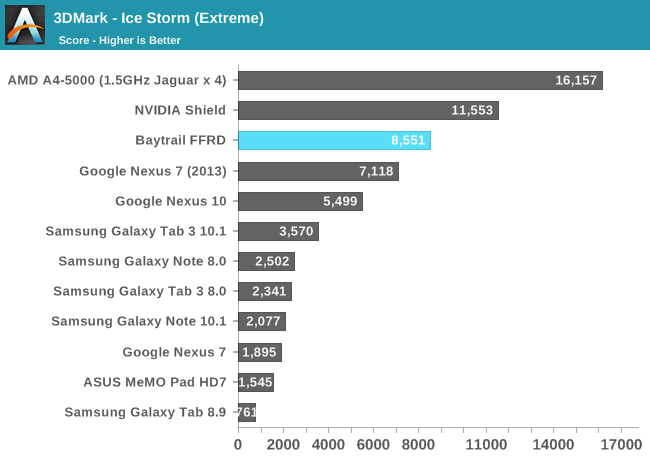
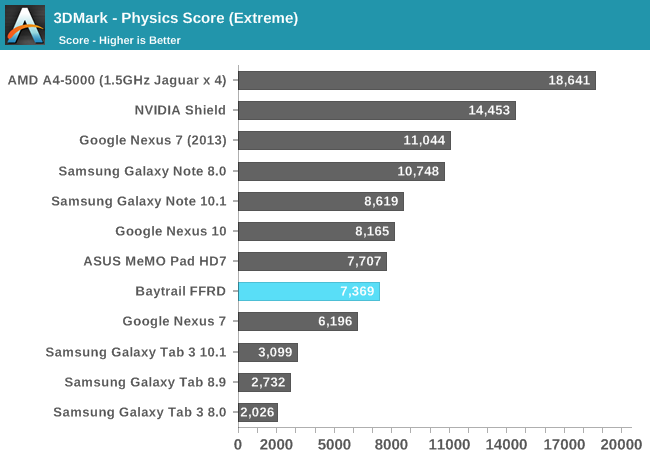
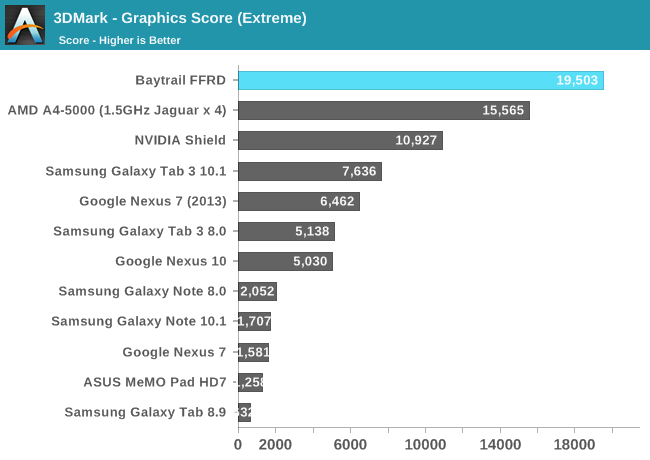
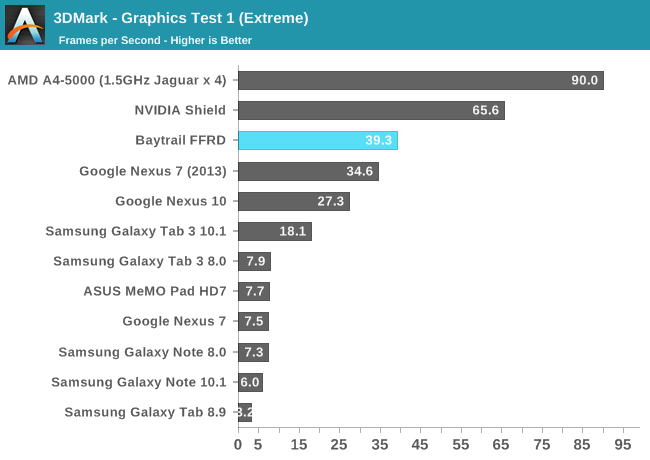
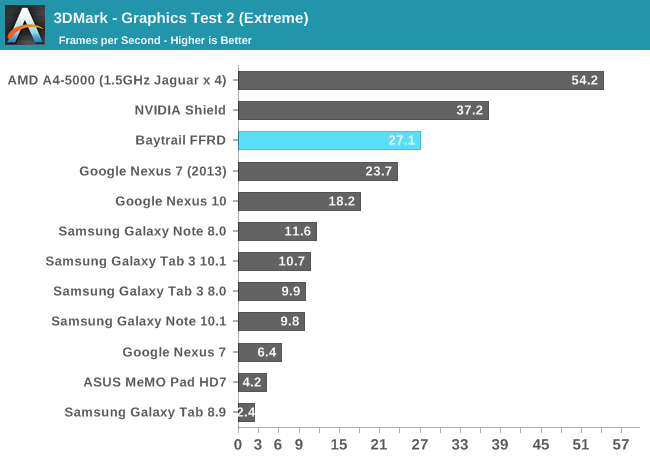
Basemark X
Basemark X is a bit more GPU bound than 3DMark, and we also have iOS data here so we can put Bay Trail's performance in better perspective. Here Bay Trail is a bit slower than the iPad 4, and clearly Tegra 4 and Snapdragon 800. Intel's GPU in Android is measurably quicker than Adreno 320/S600 though.
Bay Trail's onscreen performance is penalized by the FFRD's extremely high native resolution.

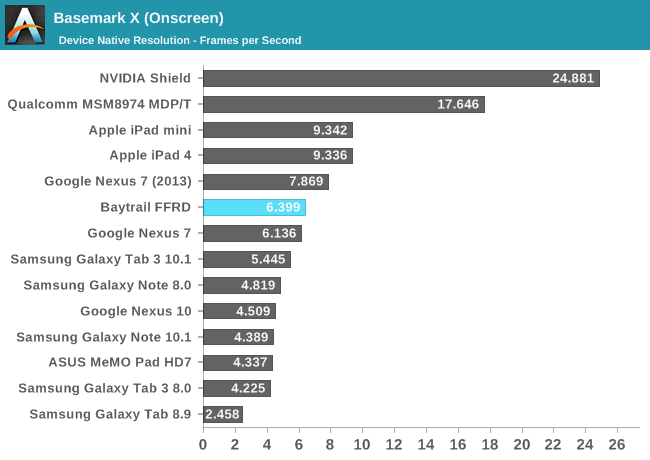
GLBenchmark 2.7
The more interested GLBenchmark numbers, T-Rex HD, show Bay Trail just behind the iPad 4 in performance. It's definitely not bad at all but clearly not industry leading.
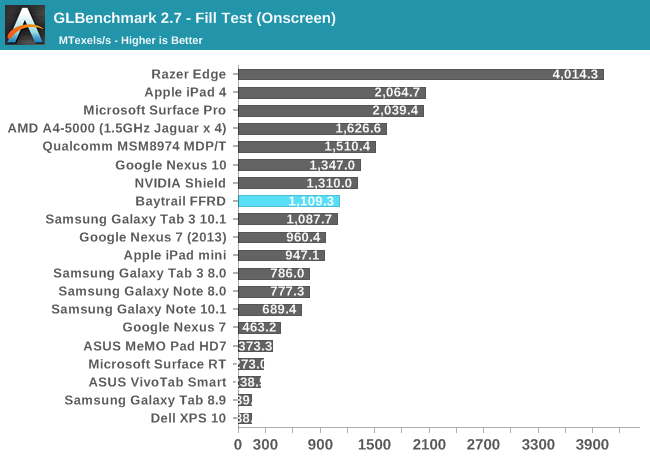
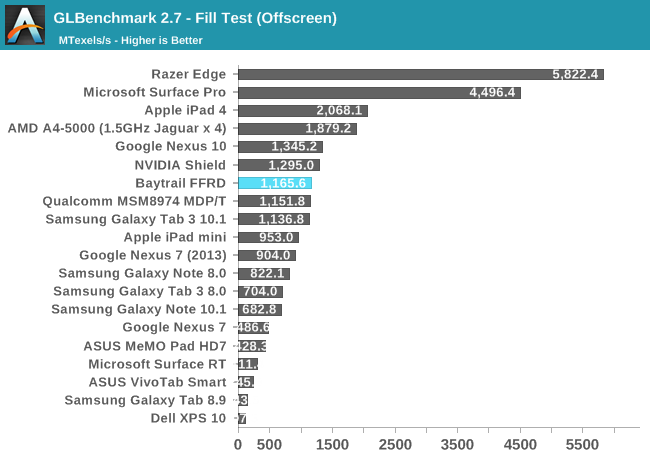
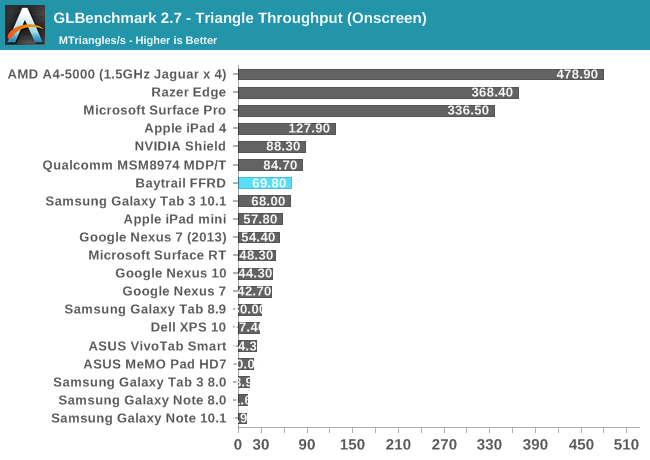
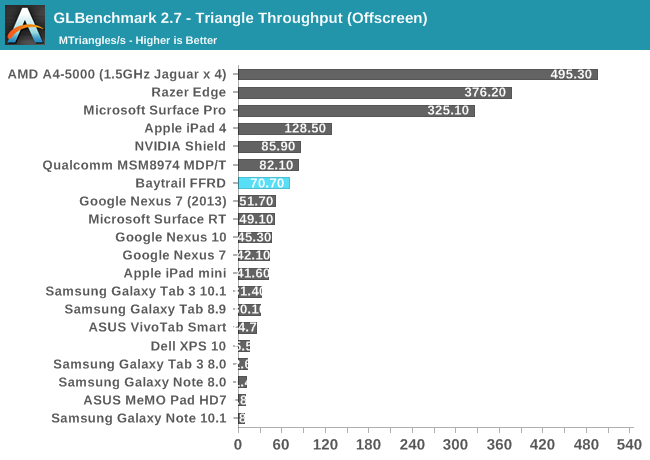
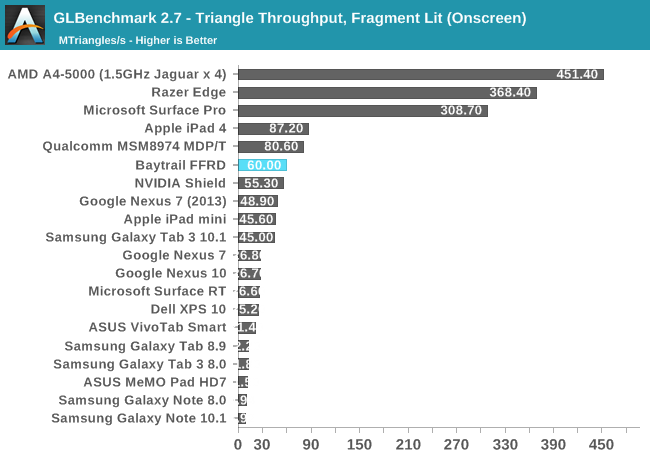
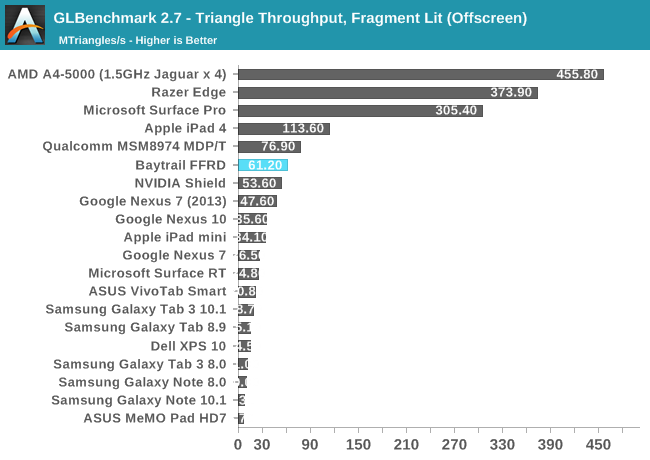
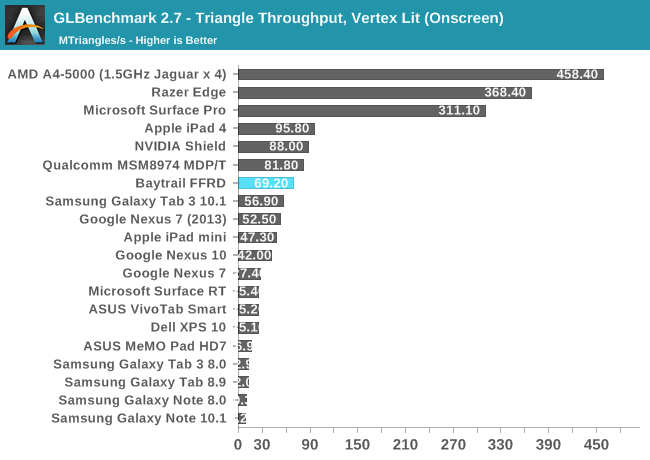
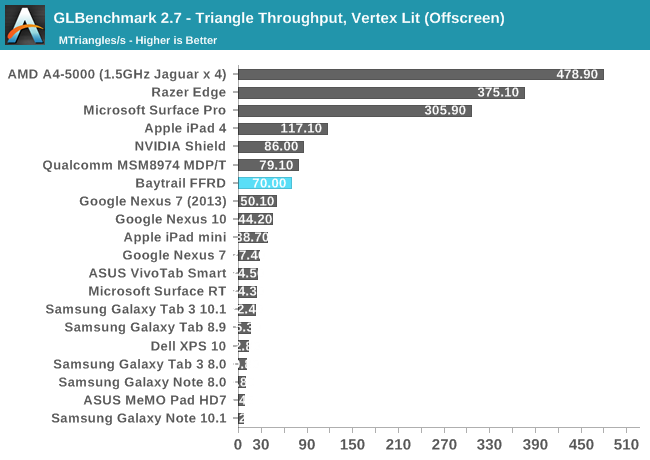
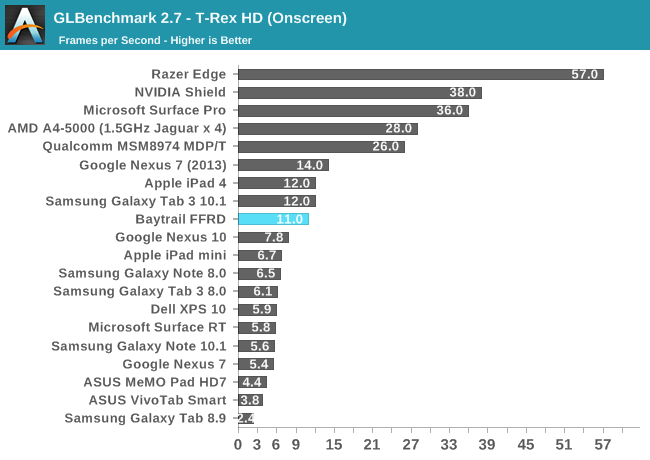
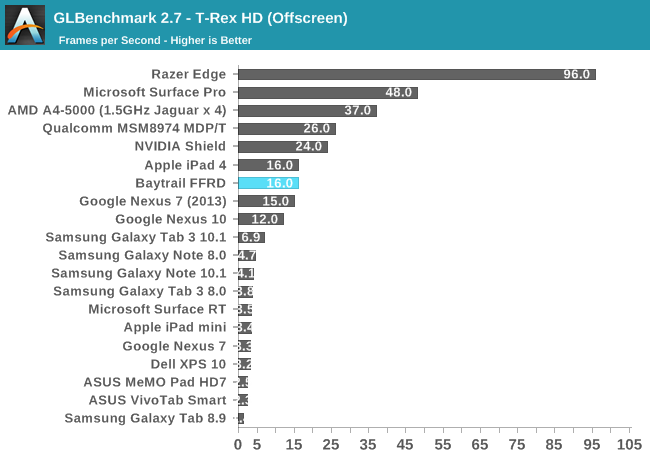
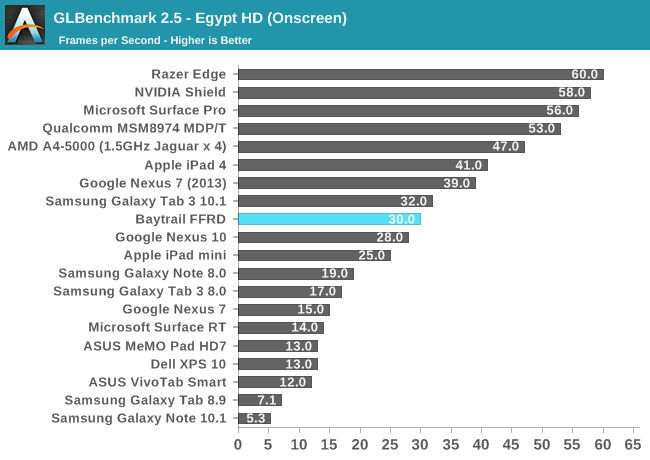
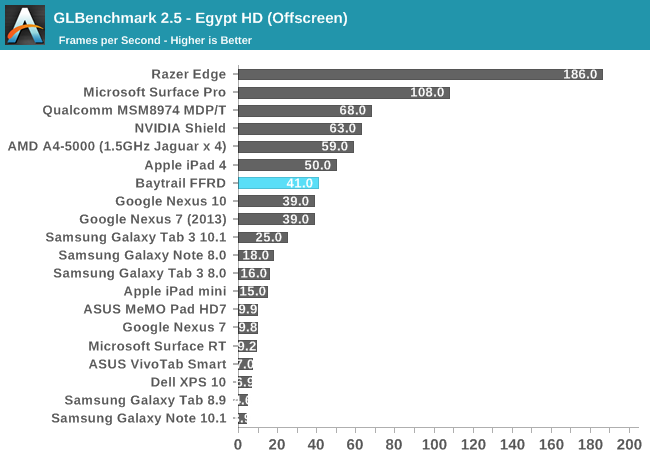
















190 Comments
View All Comments
name99 - Wednesday, September 11, 2013 - link
Uhh, his point is COMPLETELY valid.The actually existing usage models of these devices is very much short sprints for which high throughput is ideal, followed by long bursts of doing nothing. Yes, this doesn't match a particular class of games, and doesn't match whatever weird inappropriate process (like cinebench) that you want to run on your phone, but it matches how MOST people uses their phones (and tablets).
This is the one area where, IMHO, Intel have a clear advantage over ARM. But I suspect it is very much a temporary advantage. Apple, for example, obviously spent all their A7 design time getting the 64-bit in place, and on the remaining low-lying micro-architectural fruit. But I expect that for the next chip, this sort of ability, to turbo up to high frequencies for short periods of time, will be their primary focus.
romanov123 - Wednesday, September 11, 2013 - link
Well, how about Skype/Google hangouts or watching a movie? Most turbo benefits will also show up in launching apps.And as you say Apple still needs to figure out Turbo while Intel has launched a product with it.
Valis - Wednesday, September 11, 2013 - link
No x64? Guess I wont be getting one of these, right now then. I'd rather run Ubuntu on it than Android, since the latter is better for smartphones. Ubuntu being based on my beloved Debian that I have been using since the stoneage of linux. =)blandge - Wednesday, September 11, 2013 - link
Bay Trail supports 64bit for Windows and Linux.Valis - Wednesday, September 11, 2013 - link
Quote:"Although the core architecture is 64-bit in design, there will be no OS support for 64-bit Bay Trail at launch. Windows 8.1 with Connected Standby appears to still be 32-bit only, and obviously Android is 32-bit only at this point as well."
So, it's just the drivers and such missing? Ohh, okej then. :)
lmcd - Wednesday, September 11, 2013 - link
Yeah it's just the power optimizations landed in 32-bit first (probably easier plus 32-bit is all that's needed for these LP devices)RU482 - Wednesday, September 11, 2013 - link
Yeah, they said CedarTrail was supposed to have 64-bit support to, but then pulled the rug at the last moment. These BayTrail-t CPUs are going to be so short lived, don't expect much from Intel support after about January (if that long). They dedicate the resources to Airmont-tzeo - Wednesday, September 11, 2013 - link
Cedar Trail technically did but because it used Imagination GPU the driver support never materialized, especially after Intel decided to give up on netbook range ATOM and re-purposed it for the mobile market. Even some of the D Series Cedar Trail models were terminated in the same year of release.Bay Trail, though is using Silvermont architecture that is fully 64bit and is using Intel's own GMA based on a scaled down version of the Ivy Bridge HD4000... and Linux support for Intel's driver support was added back in April btw!
The only thing is Intel isn't pushing the 64bit advantage for mobile devices but Bay Trail is also going into Laptops and desktops/servers... specifically the Bay Trail M and D series that'll be sold under the Celeron and Pentium Brand names will be when they push the 64bit advantage but since it's the same architecture it means you should be able to get drivers for all Silvermont based devices...
Freddo - Wednesday, September 11, 2013 - link
I look forward to the day when these energy efficient processors are powerful enough to properly run a PS2 emulator, but it seems like I have to wait a few more years still.Dentons - Wednesday, September 11, 2013 - link
Yes, it's better than ARM, but is it better enough?Clearly, the answer is no. For most tablets and phones, it's not nearly better enough.
Convincing existing ARM vendors to move to Intel will not be an easy task. There will be huge costs involved. In order to drive such a move, Intel would need far better performance or a far better price point, but probably both. It seems unlikely that Intel has either. The performance is only minimally better than ARM's current offerings, and while we don't know pricing, given that Intel has the highest margins in the industry and ARM among the lowest, one must assume that Intel's new silicon won't be price competitive with ARM.
So where will these chips shine? The only place they seem likely to find a home is in full (non-RT) X86 Windows 8 tablets and phones. Windows is the only large mobile player that requires X86. For the rest of the market, X86 is a liability.
Intel may mark this a success if it kills off Windows RT. In that singular goal, these chips seem likely to succeed. Such a victory will do little to make Intel powered tablets competitive with Android. Full X86 Windows boxes will have the full duo of WinTel taxes. Because of this, it's hard to see these products ever being price competitive with Android, not to mention the dearth of mobile apps on the Windows platform.
Intel and Microsoft have allowed ARM and Android too large of a head start. Now, their lead may be nearly insurmountable.